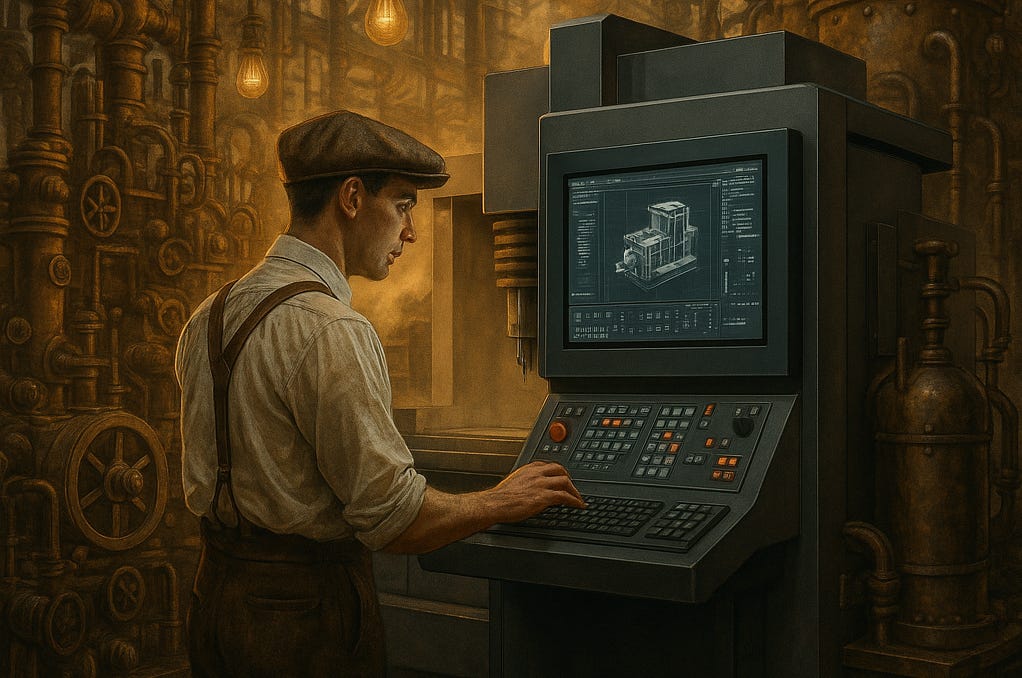1. Stop Integrating AI. Start Operating on it.
We’re in the early days of a shift that will redefine how work gets done — and not just because of AI, but because of what AI makes possible.
Most organizations still see AI as a tool to plug into existing workflows. That framing misses the point — and worse, it locks them into incrementalism. The real transformation isn’t about faster automation or smarter apps. It’s about a reorientation of how decisions are made, how teams operate, and how value is created. It’s not just a tech shift — it’s an operating model shift.
When AI levels the playing field to make content, code, and automation cheap — judgment gets more expensive.
Scarcity Has Shifted
In the industrial era, the bottleneck was muscle. Machines solved that.
In the information era, the bottleneck became code. Developers and engineers who could scale logic into software held the keys to competitive advantage.
Now? The bottleneck is productive cognition — the ability to make sense of inputs, navigate uncertainty, and make decisions with speed and clarity.
AI collapses the cost of certain types of thinking to near-zero. It can draft, summarize, sort, synthesize, and propose — on demand, at scale, across functions. In some contexts, it even executes.
When something that was scarce becomes abundant, the game changes.
AI Isn’t Just a Better App. It’s a New Factor of Production.
We need to stop talking about AI like it’s just a set of new tools, and start thinking of it as a new factor of production — like labor, capital, cloud computing, or electricity.
This distinction matters. Tools improve processes. Factors of production transform entire systems.
The companies that thrive in this new era won’t be the ones with the most AI integrations — they’ll be the ones that reimagine how value is created with AI baked into the fabric of how the organization operates.
The Electricity Analogy
When electricity was introduced into manufacturing, the first wave of adopters did what seemed logical: they replaced their steam engines with electric motors. Same processes, just now “electrified.”
The gains were real, but modest. Marginal efficiency. Some cost reduction.
But the second wave of adopters — the ones who redesigned their entire factory layouts to take advantage of distributed power — those were the companies that crushed it. They rearranged workflows. They introduced assembly lines. They changed team structures. They rethought safety, speed, and productivity from first principles.
They weren’t integrating electricity — they were operating on it.
That’s where we are with AI right now.
Real Advantage Comes From Operational Redesign
Just plugging AI into legacy workflows is like bolting an electric motor onto a steam-powered assembly line. It’ll work. But it won’t transform anything.
To actually gain sustainable advantage, you have to ask harder questions:
What decisions could now be made differently — or entirely by AI?
How do teams interface with AI: as assistants, collaborators, or autonomous agents?
What governance needs to exist to ensure accuracy, compliance, and alignment?
Where do we need new roles — prompt engineers, cognitive architects, AI trainers?
What processes can now operate continuously or asynchronously with AI in the loop?
None of those questions are solved by choosing the “best LLM.” They’re solved by designing a Cognitive Operating Model — a framework that defines how intelligence flows through the business, how decisions are made, and how humans and machines collaborate.
Implications for Leadership
If you’re a leader right now, your job is no longer just to “buy the right tools” or “greenlight the right AI pilot.”
Your job is to:
Map decision points — where judgment is made, friction slows progress, or risk hides.
Clarify delegation boundaries — what AI can handle, what requires oversight, and where human review is essential.
Design governance models — ensuring outputs are aligned, auditable, and explainable.
Enable new behavior — retrain teams not just to use AI, but to think differently with AI.
In other words: shift your thinking from integration to orchestration.
Final Thought: The Cognitive Advantage
Every company is going to have access to increasingly similar AI capabilities. The models will keep commoditizing. The tools will get easier to plug in.
But the real advantage won’t come from access. It will come from how you structure your business to think, decide, and act faster than your competitors.
That’s the edge.
AI isn’t just the next feature.
It’s the foundation of your next operating model.





Yes, this is right on. And it goes deeper. We're not just in the midst of operational and technology shift, but a change in the very logic we put towards problems.